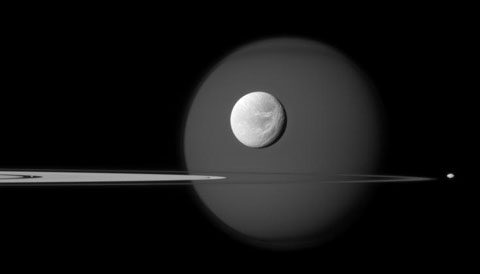Astronomers have found one of the best exomoon candidates based on data collected by the Kepler spacecraft. Now they just need the Hubble observations to check if it exists.

NASA / JPL-Caltech / Space Science Institute
Astronomers have found thousands of exoplanets orbiting their host stars. Yet, despite thousands of observations, one type of detection has proven elusive: the signal of an exomoon.
In our own solar system, moons are common; Jupiter and Saturn are each surrounded by dozens of them. Now, a group based in Columbia University Cool Worlds Lab have used a novel statistical technique to quantify just how many exomoons might be out there. Intriguingly, their results point out one leading candidate.
The study, conducted by Alex Teachey and David Kipping (both at Columbia University), and Allan Schmitt (a citizen scientist), used a high-quality subset of known planets to search for exomoons.The Kepler spacecraft had spotted the planets indirectly, by the dips in stars’ brightness caused when the planets transited, or passed in front of, their host stars.
Kepler can measure stars’ brightness levels with exquisite precision, detecting changes down to 40 parts per million. That’s enough to find Earth-size planets around Sun-like stars but not nearly enough to detect moons around those planets. Furthermore, hunting for individual moons is not as straightforward as detecting planets. Because the moons are orbiting the planets, their transits won’t follow the same timing as the planet’s transits. The moon could sometimes lead and sometimes lag behind its planet, and other times it might not be detected at all.
To circumvent these challenges, Teachey and his collaborators used a powerful statistical method to examine an entire population of planets. While they lost the ability to carefully detect individual candidates, they were able to quantify the how often massive moons, like the Galilean moons of Jupiter, exist in the systems that Kepler studied.
The team looked at 284 of Kepler’s highest-quality lightcurves of known transiting planets, which show how the host star’s light changes over time as the planet passes in front of it, Then they stretched those transit signatures so that they were all roughly the same shape, and combined them. This allowed them to cleanly remove the planet transits from the average lightcurve and quantify other signals that appear around the same time, when a moon might be transiting. They found that about 1 out of 6 planets might host a massive exomoon.
But that’s not what got everyone’s attention. During the course of their analysis, the team also used a much simpler model to look for exomoons in individual systems. In doing so, the astronomers uncovered one of the best exomoon candidates to date: Kepler 1625b-i (the “b” denotes the planet and the “i” denotes its moon).
Unfortunately, Kepler had only captured three of Kepler 1625b’s transits in front of its host star, making the identification of its moon uncertain. But if the exomoon does exist, it would be huge — literally! The candidate appears to be the size of Neptune, orbiting a planet a little larger than Jupiter.
The team will test the exomoon’s existence with Hubble observations later this year, which will examine an upcoming transit of the planet and, potentially, its moon. Until those data arrive, though, the moon around Kepler 1625b will only be a tantalizing possibility.
 1
1









Comments
Robert-Casey
August 15, 2017 at 11:36 am
Maybe astronomers could use the Hubble space telescope to look at Kepler 1625b at more of its next scheduled transits to get more data?
You must be logged in to post a comment.
You must be logged in to post a comment.